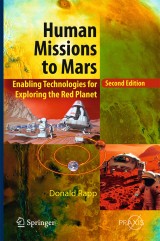Details

Human Missions to Mars
Enabling Technologies for Exploring the Red PlanetSpringer Praxis Books 2nd ed. 2016
|
223,63 € |
|
| Verlag: | Springer |
| Format: | |
| Veröffentl.: | 31.10.2015 |
| ISBN/EAN: | 9783319222493 |
| Sprache: | englisch |
Dieses eBook enthält ein Wasserzeichen.
Beschreibungen
<p>A mission to send humans to explore the surface of Mars has been the</p> <p>ultimate goal of planetary exploration since the 1950s, when von Braun</p> <p>conjectured a flotilla of 10 interplanetary vessels carrying a crew of at</p> <p>least 70 humans. Since then, more than 1,000 studies were carried out</p> <p>on human missions to Mars, but after 60 years of study, we remain in the</p> <p></p>early planning stages. The second edition of this book now includes an<p></p> <p>annotated history of Mars mission studies, with quantitative data wherever</p> <p>possible.</p> <p>Retained from the first edition, Donald Rapp looks at human missions</p> <p>to Mars from an engineering perspective. He divides the mission into a</p> <p>number of stages: Earth’s surface to low-Earth orbit (LEO); departing from</p> <p></p>LEO toward Mars; Mars orbit insertion and entry, descent and landing;<p></p> <p>ascent from Mars; trans-Earth injection from Mars orbit and Earth return.</p> <p>For each segment, he analyzes requirements for candidate technologies.</p> <p>In this connection, he discusses the status and potential of a wide range</p> <p>of elements critical to a human Mars mission, including life support</p> <p>consumables, radiation effects and shielding, microgravity effects, abort</p> <p></p>options and mission safety, possible habitats on the Martian surface and<p></p> <p>aero-assisted orbit entry decent and landing. For any human mission to</p> <p>the Red Planet the possible utilization of any resources indigenous to</p> <p>Mars would be of great value and such possibilities, the use of indigenous</p> <p>resources is discussed at length. He also discusses the relationship of lunar</p> <p>exploratio</p>n to Mars exploration.<p></p> <p>Detailed appendices describe the availability of solar energy on the Moon</p> <p>and Mars, and the potential for utilizing indigenous water on Mars.</p> <p>The second edition provides extensive updating and additions to the first</p> <p>edition, including many new figures and tables, and more than 70 new</p> references, as of 2015.
Why Explore Mars?.- Planning Space Campaigns and Missions.- 60+ Years of Humans to Mars Mission Planning.- Getting There and Back.- Critical Mars Mission Elements.- In Situ Utilization of Indigenous Resources.- Why the NASA approach will likely fail to send humans to Mars for many decades to come.
<p>A mission to send humans to explore the surface of Mars has been theultimate goal of planetary exploration since the 1950s, when von Braun envisaged a flotilla of 10 interplanetary vessels carrying a crew of at least 70 humans. Since then, more than 1,000 studies have been carried out on human missions to Mars, but after 60 years of study, we remain in the early planning stages. The second edition of this book now includes an annotated history of Mars mission studies, with quantitative data wherever possible.</p><p><br></p><p>As in the first edition, Donald Rapp looks at human missions to Mars from an engineering perspective. He divides each mission into a number of stages: Earth’s surface to low-Earth orbit (LEO); departing from LEO toward Mars; Mars orbit insertion and entry, descent and landing; ascent from Mars; trans-Earth injection from Mars orbit; and Earth return. For each segment, he analyzes requirements for candidate technologies. In this connection, he discusses the status and potential of a wide range of elements critical to a human Mars mission, including life support consumables, radiation effects and shielding, microgravity effects, abort options and mission safety, possible habitats on the Martian surface and aero-assisted orbit entry descent and landing. For any human mission to the Red Planet the possible utilization of any resources indigenous to Mars would be of great value; such possibilities are discussed at length. He also discusses the relationship of lunar exploration to Mars exploration.</p><p><br></p><p>Detailed appendices describe the availability of solar energy on the Moon and Mars, and the potential for utilizing indigenous water on Mars.The second edition provides extensive updating and additions to the first edition, including many new figures and tables, and more than 70 new references, as of 2015.</p><div><br></div><p></p>
Offers a highly readable yet realistic view of the possibilities for human missions to Mars Provides for the first time a ‘level-headed’ assessment of plans for human exploration of Mars to counteract the tendency of space agencies to take an over-optimistic approach to such interplanetary missions Collects together into a single, handy reference, a wide range of material on human missions to Mars that is currently widely dispersed and fragmented in the literature Describes in detail the requirements and characteristics of human missions to Mars and assesses current space agency plans in the light of such requirements Contains a large number of black and white and colour illustrations and line diagrams illustrating the many practical aspects of planning and executing human missions to Mars Details the history of planning Mars missions, the technologies needed, the mission concepts, and NASA activities. It also provides details on solar energy and water availability Includes supplementary material: sn.pub/extras

















